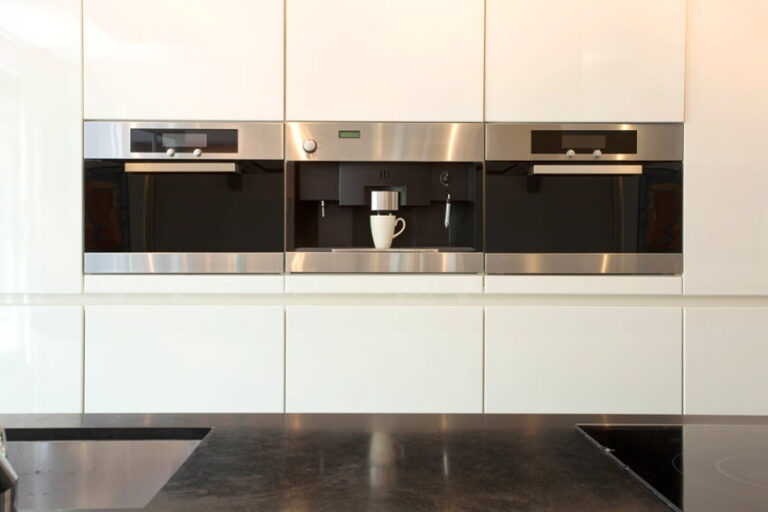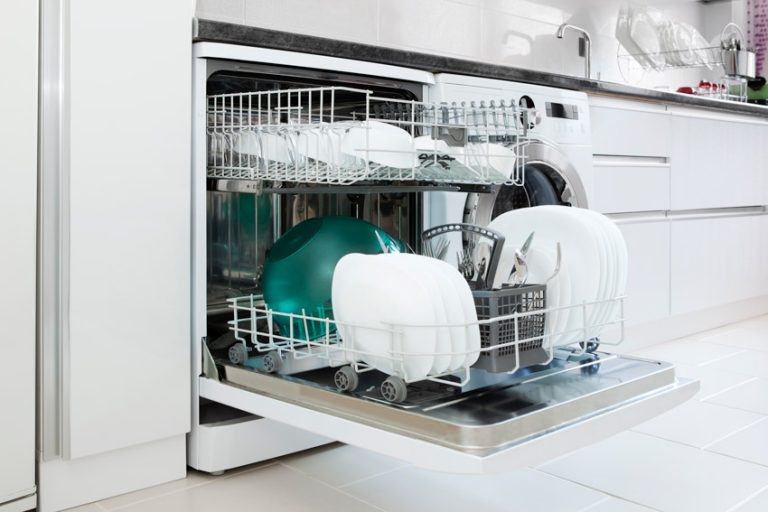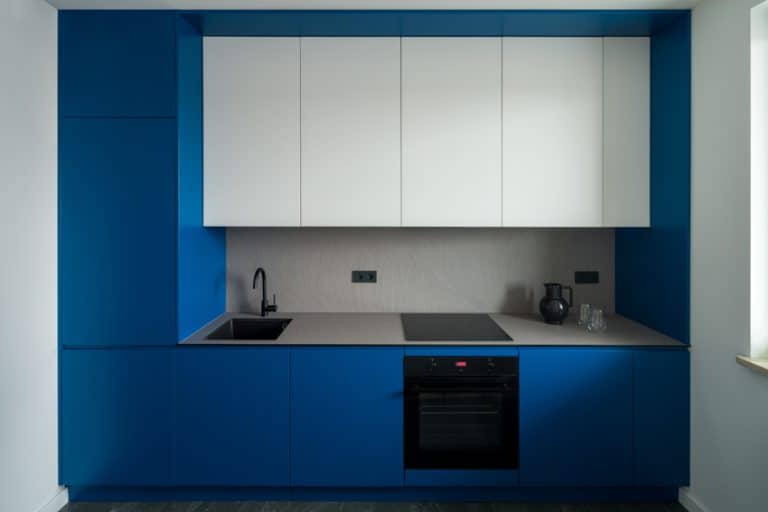Backsplash Behind Stove (15 Best Kitchen Materials & Designs)
Here we share our backsplash behind stove ideas, including the best tile materials like marble, ceramic, granite, stainless, and pearl & shell.
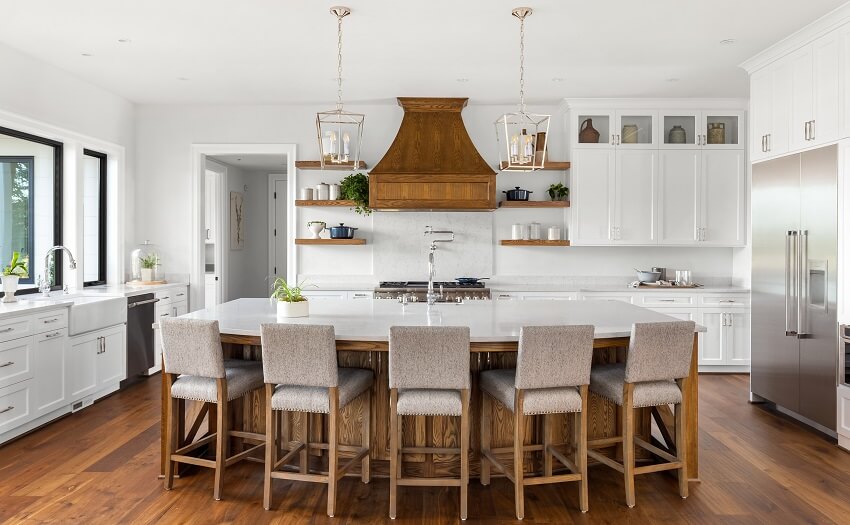
Laying the backsplash behind the stove is a worthwhile option to promote the longevity of your kitchen. Not only can an easy-to-clean tile save the need for scouring, but it can also create the ideal aesthetic for your kitchen design.
A well-selected behind-the-stove backsplash will serve two functions: shield your walls from stains and spills and make a statement in your kitchen area.
When selecting tiles for behind a stove, the possibilities are nearly limitless, but you will want to weigh a few critical evaluations before making your ultimate choice. Kitchen backsplashes must be both functional and aesthetically pleasing.
The backsplash must be easily cleaned during the clean-up phase of dinner preparation and should also complement the general style of your kitchen.
Can You Put A Backsplash Just Behind The Stove?
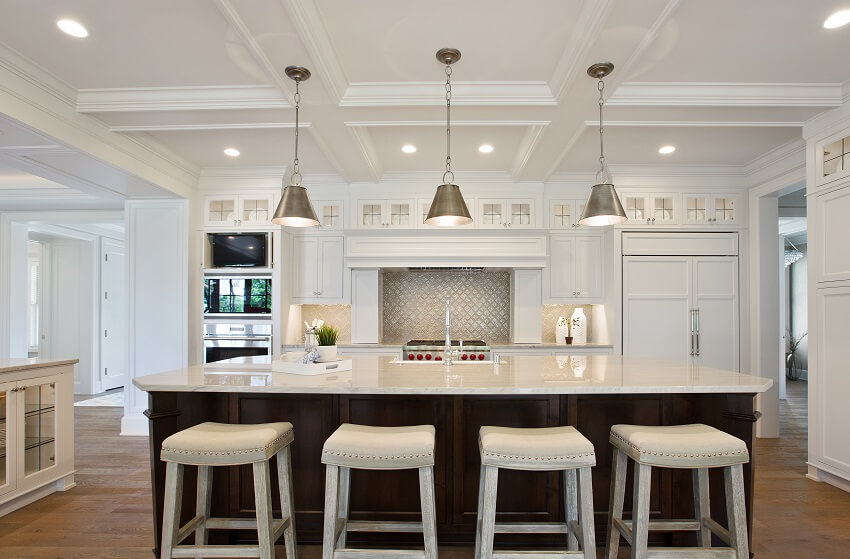
If you are on a limited budget but still want a gorgeous backsplash, you can always install it behind the stove exclusively. Regarding efficiency, the materials you select must effectively prevent food stains from ruining your wall.
Ideas For Backsplash Behind the Stove
Here are a few kitchen behind-the-stove backsplash ideas that can improve the overall attractiveness of your kitchen. Each has its distinct flair, and some can only be used in a particular design.
Tile Backsplash
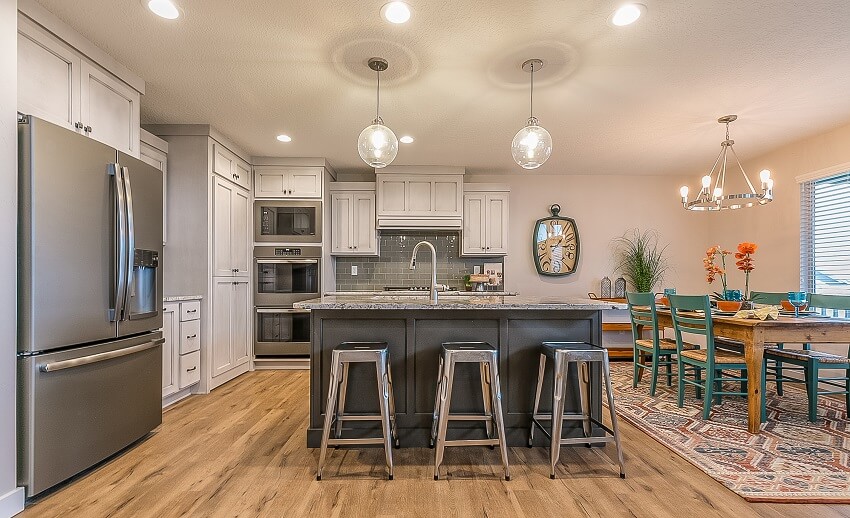
A tile backsplash directly behind your stove can only be used as a type of accent wall. This is a good idea if you love a tile but don’t want to overdo it or if you want to bring in a touch of color without it being overwhelming.
A popular choice for contemporary and traditional kitchens is using subway tile backsplash. These rectangular-shaped tiles look stylish and offer superior protection against high heat and moisture. You can use different color grout to enhance the style and make the style stand out.
Ceramic Tile Backsplash
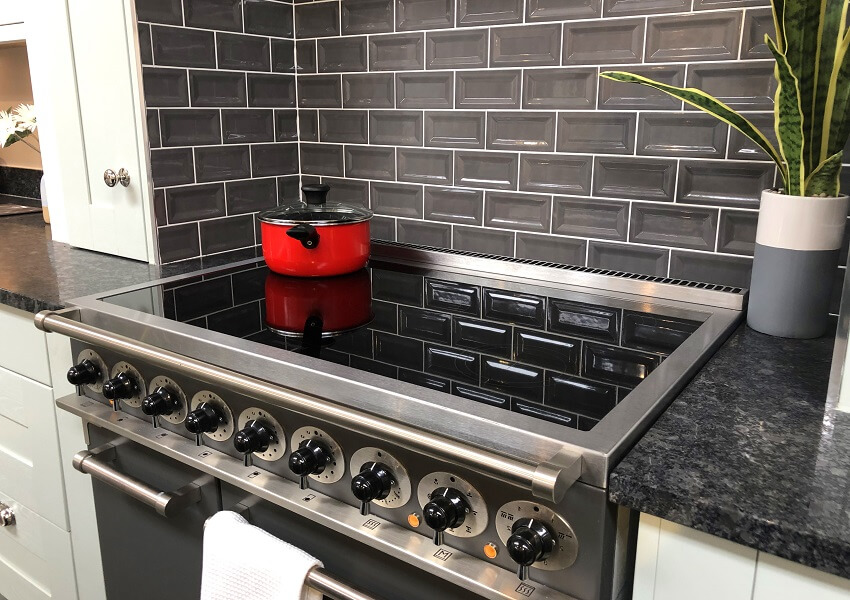
Behind-the-stove ceramic tile backsplashes give a long-lasting, heat-resistant layer that protects against frequent oil spills and sauce splatters while also leaving plenty of space for unique kitchen wall décor.
With a reasonable cost per square foot and a wide range of colors and patterns, these behind-the-stove tiles are one of the greatest low-maintenance solutions if you aim to simplify matters in your kitchen.
Marble Backsplash
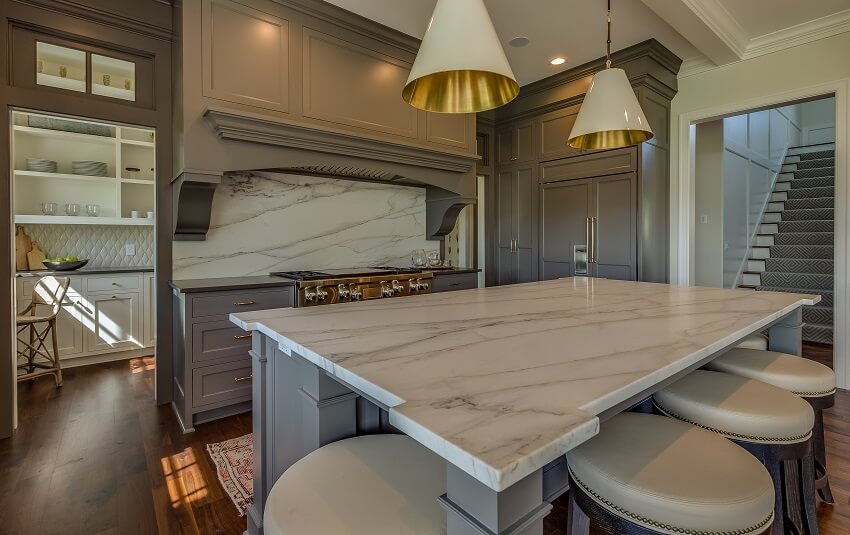
Marble tiles are an appealing selection for a gorgeous backsplash design behind a stove, with a robust surface that is inherently resistant to heat. Nothing makes a lasting impression more than a magnificent marble and natural stone, but its genuine grandeur must be preserved and protected.
Grease and grime are more inclined to penetrate the corners and crevices in your tile the more “natural” your stones are – such that the more grainy and gritty they are. Rather than rough stones, stone tiles with a polished appearance are a great option.
Since all-natural stone tiling options are porous, even if you have marble, travertine, slate, or any other natural stone, you must ensure that your tiles are sealed on a frequent schedule to prevent stains from being collected.
The classy aesthetic that a marble backsplash brings to any kitchen aesthetic is worth having. There are countless and gorgeous possibilities to achieve the ultimate appearance for your kitchen, whether you like a traditional marble subway tile design or a creative twist with a marble mosaic arrangement.
Pearl and Shell Backsplash
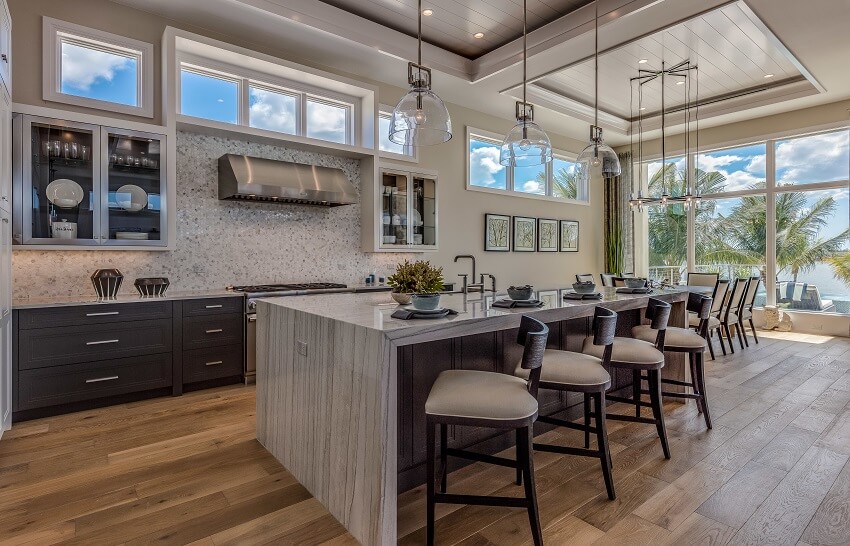
Pearl and shell tiles are becoming a must-have for luxurious interiors. Notwithstanding their exquisite and radiant sheen, they are a remarkably long-lasting tile material, especially behind your stove.
This gorgeous natural material is cut from the internal layer of shells to give the backsplash tiles a pearly sheen. They look great with other materials but also great on their own.
Even though the pearl surface is incredibly durable, a perfect choice for heavy-duty scouring after cooking, it does necessitate some maintenance. It is always suggested that you seal your stunning shell tiles to ensure that they last as long as necessary.
Once you decide to apply this material, you should also prevent harsh chemical-based cleaners to avoid ruining the surface and ensure the luster remains gorgeous. If your pearl and shell tiles have been correctly sealed and maintained, you must be able to quickly wipe up spillages with a wet towel.
This tile selection comes with a plethora of groutless tile selections. With minimal grout lines, there is even less to scrub, which is a win-win situation. Although a little quantity of grout might be required to fill in between mosaic layers, these tiles offer an overall seamless finish behind the stove.
Stainless Steel Backsplash
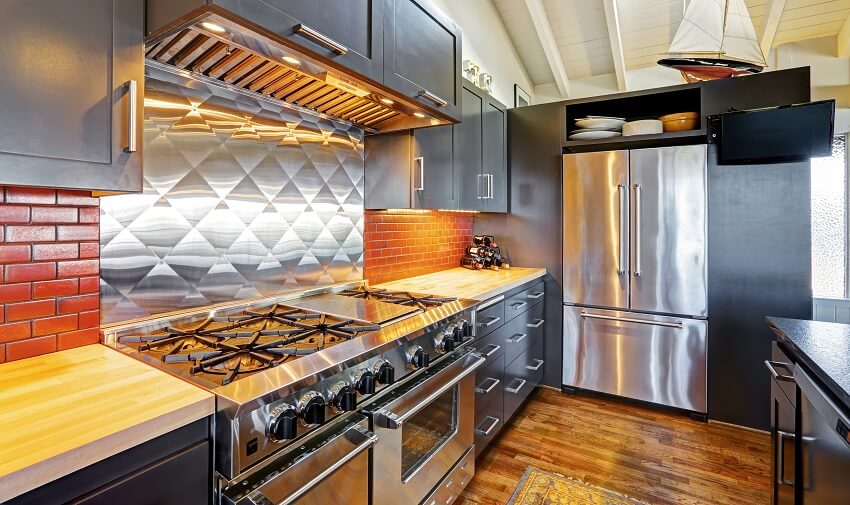
Stainless steel behind-the-stove backsplash is functional and cost-effective for a variety of reasons. It is simple to clean and extremely resistant to heat and water thus, it will not be affected by temperature or spraying water from the faucet.
Stainless metal materials also last for years since they do not need to be re-polished, and they are sanitary enough to prevent bacteria from spreading.
Type 304 is the most adaptable and commonly utilized stainless steel type. This material gives the highest all-around functionality because of its chemical structure, mechanical qualities, and corrosion tolerance. Stainless sheets are available in a wide range of sizes, diameters, and finishes.
Light is absorbed and reflected by stainless steel, and as a result, the stove area appears larger than it is. This approach produces such an appearance and gives the entire kitchen a high-end feel. Your kitchen becomes more modern-looking with stainless steel finishes.
Accent Backsplash
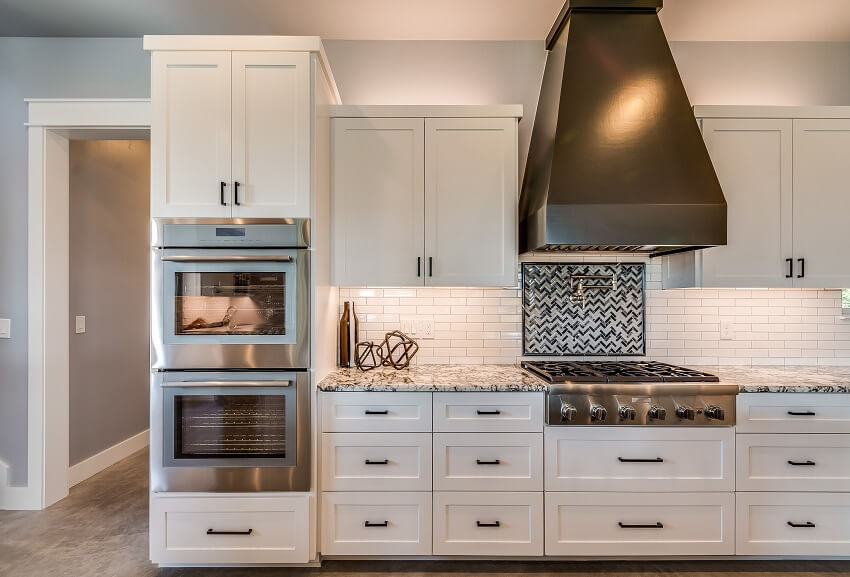
You can establish a centerpiece by using various materials behind the stove. You may create an accent wall behind the stove in your kitchen by placing a complementing tile all the way to the ceiling. In a kitchen with high ceilings, an accent wall can add a stunning impact.
Accent walls offer interest, delight, and even beauty to a plain kitchen backsplash through the application of contrast. Whether you prefer to emphasize the color, pattern, size, shape, or surface of the tiles, the arrangement of the accent walls in your behind-the-stove influences how striking the transition is.
Long and rectangular accent walls behind the stove work well with borders along the corners. Such borders can be placed behind the stove on outer wall edges or an inch or two within the edge.
The border can be as small as one tile or as big as you like, and it can run along the upper, lower side, or both sides of the wall.
By integrating accent tiles into your behind-the-stove backsplash layout, you can properly combine them into the overall aesthetic. Installing four square accent tiles diagonally in a pattern generates a place for a tiny square tile in an accent piece.
Rather than color, texture is a simple yet effective technique for variation in accent tiles. Whether you use polished tiles against coarse, unglazed ones or ceramic tiles as a border, complementing accent finishes give a good contrast.
Fireproof Backsplash
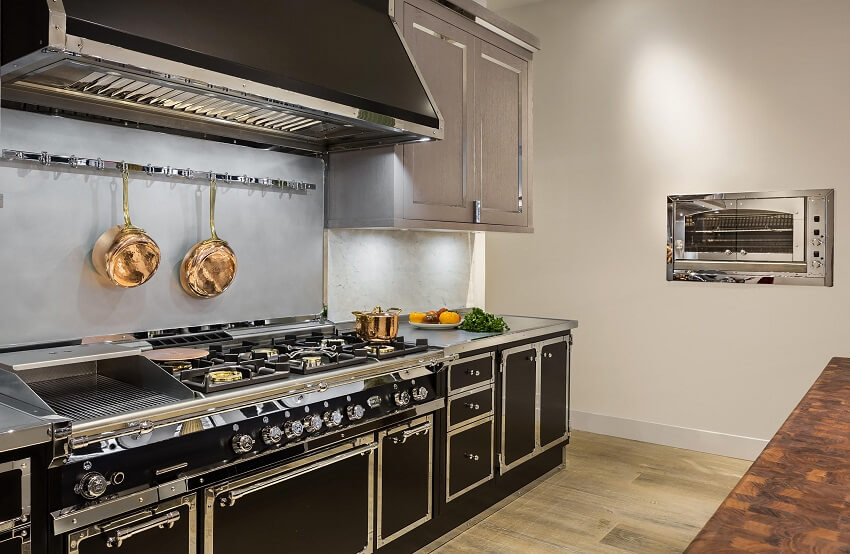
The two entirely fireproof backsplash materials are glass and concrete. Let us talk about these two fireproof behind-the-stove materials:
Glass Backsplash
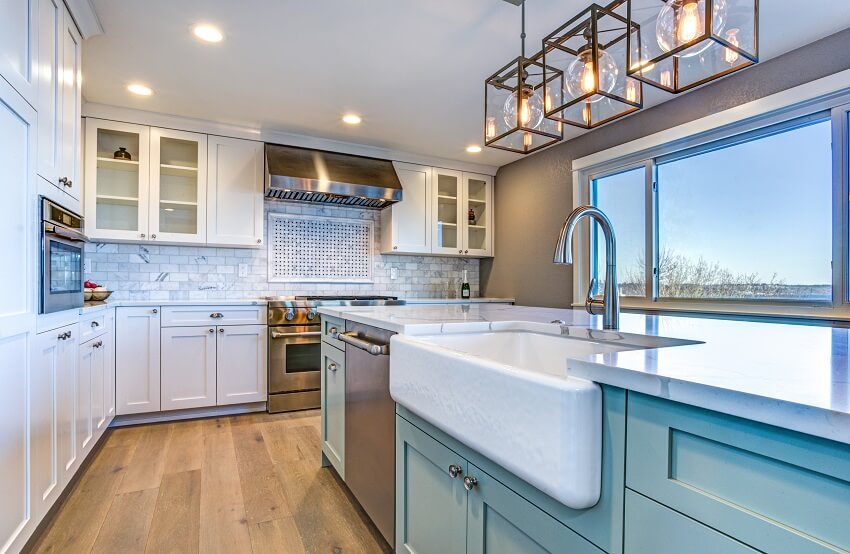
Glass is indeed a wise option for a behind-the-stove backsplash, particularly if you are using a gas-powered stove. This is because glass is entirely fireproof.
On the other hand, a glass backsplash is not as prevalent as the other options, but given how stunning it can appear, you can argue that it is still a very prudent selection.
Thus, glass could be a wonderful addition to contemporary and modern kitchens for several purposes, beginning with the appearance.
The appearance of behind-the-stove glass tiles is arguably the most noticeable feature. Glass backsplashes are appealing due to their modern and trendy appearance. They are stunning and enhance the stove area’s overall appearance.
Glass tiles are also quite customizable. They look fantastic in minimalist kitchens, but they are also highly versatile.
One other benefit is efficiency. Glass backsplashes behind the stove keep your walls spotless by capturing stains and keeping the kitchen looking great.
Plus, a glass material is much easier to clean than a wall with marble or other stones. Yes, spills and stains are visible on glass, but they are also quick and easy to remove, allowing you to keep your kitchen clean and appealing at all times.
Concrete Backsplash
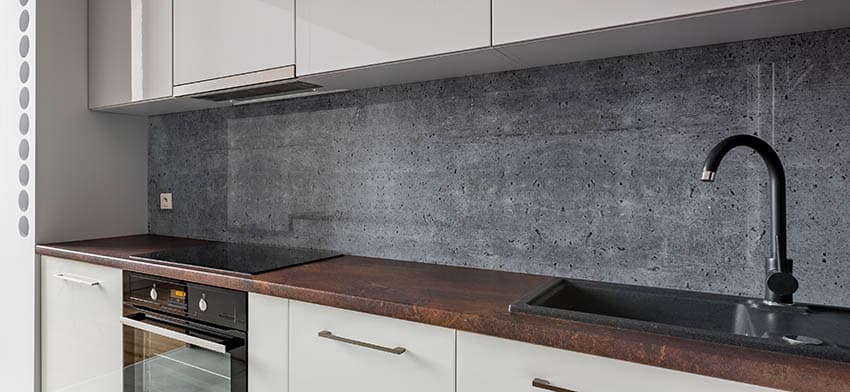
Concrete backsplashes can be produced to match your concrete-made countertop precisely, or they can be of a different pattern, style, shape, or quality. Vertical concrete coverings can also be used to conceal outdated tile backsplashes.
Concrete is completely fireproof, making it a very ideal option for behind the stove. It does not look that appealing like marble or granite, but its affordability and versatility are what make it a great option. Plus, if you are not satisfied with its look, you always have the option to paint it.
Granite Backsplash
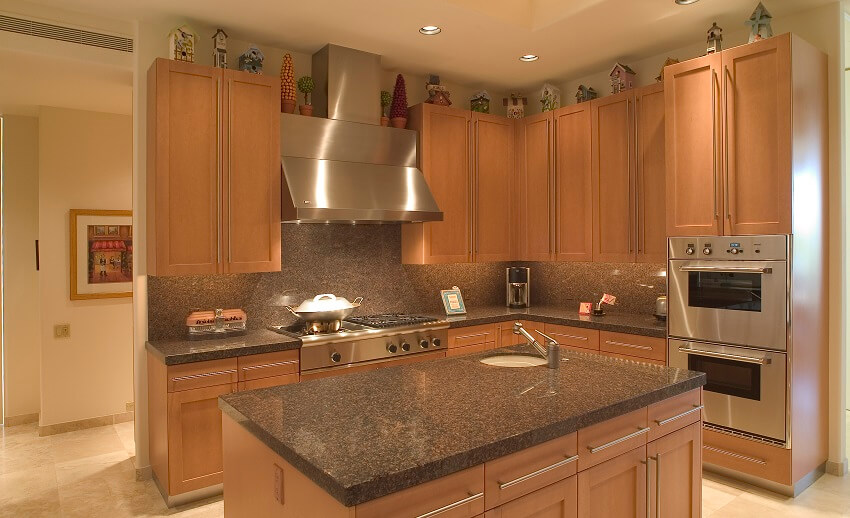
Granite is one of the most popular backsplash materials for kitchens, specifically in the stove area. Granite backsplashes are frequently produced from the very same piece as your countertops. Granite is another high-end alternative for your behind-the-stove design.
Granite, as previously mentioned, is generally cut from a similar slab as granite counters, and that is to ensure the right blend.
Even when the countertop has a rounded border, a granite backsplash usually is 3 centimeters thick and has a square border at the top. The stone tiles adhere to the wall with silicone glue, and any crevices are closed with grout.
Granite is easy to clean since it is heat-resistant and stain-resistant; hence, splashed substances and spraying frying pan grease can be readily wiped, unlike tile where debris gets trapped in the grout lines. Granite is an excellent choice for a gorgeous and easy-to-clean behind-the-stove design.
For ages, granite has been employed for kitchen backsplashes. Unlike glass tiles and mosaic tile backsplashes, this classic material maintains a contemporary appearance. Installing a granite feature wall behind your stove safeguards it from food and grease.
Quartz Backsplash

A quartz backsplash is an attractive and durable solution to use behind the stove. One can opt for a solid slab, tiles, or tile combined with other materials with excellent results. Its non-porous nature makes it easy to wipe down and clean without hassle.
Quartz is heat resistant and is generally safe to be placed within close proximity to a stovetop. However, it may be damaged by a high-power stove that produces too much heat over a long time.
Quartz mustn’t be positioned too close to gas burners, which may start to damage the surface. In addition, it may be susceptible to splashes from hot liquids or grease.
Mirror Backsplash
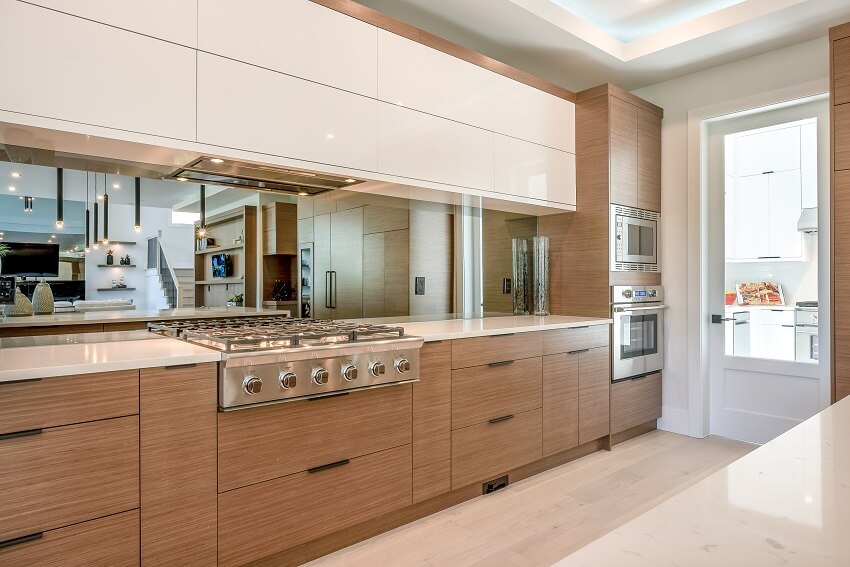
If you are renovating your kitchen, you might want to consider installing a mirror backsplash. It can range from a solitary piece of mirror to multiple mirror tiles. It has the potential to radically remodel one of the most crucial areas in your home, specifically the stove area.
Mirrored backsplashes are a popular choice in home design. It not only makes cleaning the wall behind your counter quicker, but it can also make your kitchen appear larger.
However, mirror tiles and panels are not always reflective. Though not a standard mirror, a window-type mirror panel performs all of the purposes of a mirrored kitchen wall. It is simple to clean and brightens up the space. It does, nonetheless, present the homeowner with a lovely sight of the entire area.
It is not obligatory to use a regular-fashioned mirror. The ideal behind-the-stove backsplashes are often colored.
By integrating a golden, pink, or royal blue backsplash into your stove area, you can bring some brightness to your kitchen. You may match it to the floor tiles, cabinets, and wall paint to achieve a uniform and seamless aesthetic.
Mirrored tiles in small sizes can also be utilized for mosaic designs. This gives your kitchen stove area a stylish and contemporary look.
Antique tiles can also outperform new models in terms of appearance. This sort of tile is shaded with a foggy filter, giving it a primitive and ancient appearance. Antique mirror tiles will surely add a touch of artistry to your stove area.
Wood Backsplash
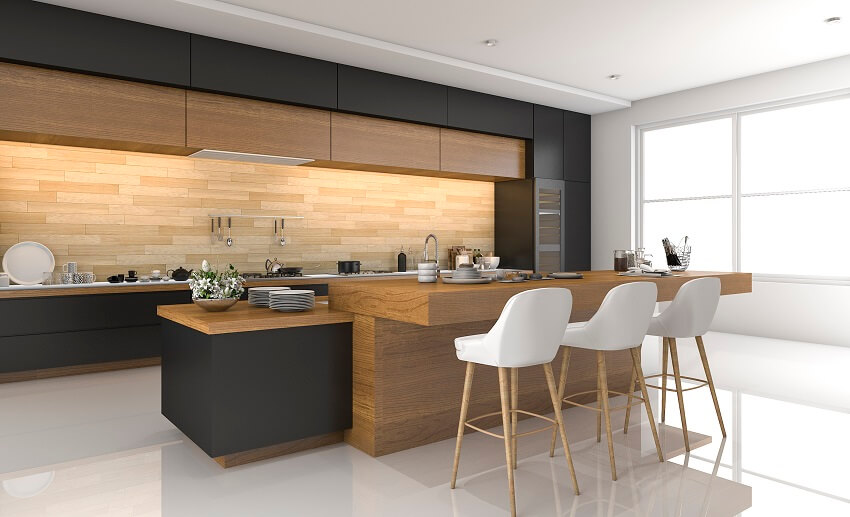
Although wood is not the most robust material on the market, wood kitchen backsplashes are a growing craze that incorporates distinctive hardwood and repurposed wood into kitchen design concepts you have never seen previously.
If you pick your material carefully, a wood slab or panel can contribute to the wall behind your kitchen stovetop. Still, a few detailed tricks of the trade are required to keep this durable material presentable when used as an alternative to a stone or tile.
Wood can be used for backsplashes; marble, stainless steel, and ceramic are typically employed because of their adaptability and longevity.
Wood can be applied to your kitchen walls in this approach, but it has various disadvantages. If you do not routinely clean and manage your wood backsplashes, they will become moldy and dirty. Therefore, if you want this one-of-a-kind aesthetic, you have a variety of woods to pick from.
Unlike standard kitchen elements like tile, wooden backsplashes occur in a variety of shapes, appearances, and styles.
The pattern and type of wood you select will be heavily impacted by the aesthetic of the kitchen style you want to achieve — a rustic-style kitchen involves distinct wooden pieces than a contemporary kitchen.
The following are the most frequent types of wood used for backsplashes:
• Plywood
• Shiplap
• Repurposed Wood
• Beadboard
• Barnwood
Each of these wooden boards boasts a distinct appearance and style, and they are available in a selection of colors and treatments to suit the walls in your stove area.
Consider your kitchen environment, how you utilize the area, and how hot your stove area gets when selecting the material for your wooden panels.
Wood Look Tile

Using a porcelain or ceramic wood look tile is another alternative to using real wood that has some benefits. Tile is generally more durable and easier to clean compared to wood. By using a tile that closely resembles the look of wood, you can get a similar look with lower maintenance.
Peel and Stick Backsplash

Some variants used are water-resistant vinyl with realistic 3D pictures, solidified silica gel tiles that appear and feel like a patterned tile surface, and even genuine mosaic tiles produced from lightweight natural materials like mother-of-pearl to make peel-and-stick behind-the-stove backsplashes.
They are available in a myriad of appealing styles that nearly replicate their natural tile contemporaries. Furthermore, they are completely a do-it-yourself candidate: simply peel off the backing and stick the peel-and-stick backsplash to the wall around your stovetop.
The highest-quality peel-and-stick sheets are also extremely low-maintenance. To clean it, simply wipe it with a moist rag. They will not get damaged as the surface is generally waterproof.
Installing a peel-and-stick product to the wall behind your stove is a straightforward way to change your kitchen’s overall design and ambiance. Aside from that, it is also considered cheap.
A peel-and-stick backsplash is typically installed on the wall just above the stovetop. Nevertheless, starting at a single end of the counter and making your way to the other might not always yield ideal outcomes.
Generally speaking, peel-and-stick materials are easy to cut with scissors or a rotary cutter, but it would be a much better idea to make a template before trimming a piece to fit it near your stove area.
When choosing this type, consider the colors and styles utilized throughout the kitchen. Several tile-look backsplash alternatives are available, like subway tile and mosaic tile, but you can also get stone-, brick-, and wood-look tiles.
Be sure that the design you choose matches the other home adornments in your interior. Select a material after thinking about how it will appear along with the rest of the kitchen’s objects and décor.
Wallpaper Backsplash

Splash-proof vinyl wallpapers are available in many designs to complement your kitchen, specifically your stove area. Splash-proof wallpaper is resistant to moisture and mold growth and can withstand scouring.
Since vinyl wallpaper is not thin, it is simpler to install than other wallpapers, especially peel-and-stick varieties. The majority of vinyl wallpapers necessitate the use of a premixed vinyl adhesive.
A heavy-duty clay-based solution, which is obtainable at any wallpaper shop, can be used. Before you begin, ensure your wall has been prepared with a high-quality primer.
Wallcovering companies have witnessed an increase in requests for commodities for application in kitchens as more individuals make design modifications to their homes in the past few decades.
Wallpaper is a great way to add character to your kitchen because they are versatile and they come in many different styles. Furthermore, they can be modified and replaced more easily than tile and stone backsplashes.
When using wallpaper as a kitchen backsplash, some people believe it is critical to shield it from heat and humidity using tempered glass. They think wallpapering the kitchen’s behind-the-stove area will only become completely functional once sealed with glass.
Best Material for Stove Backsplash

Backsplashes are normally disregarded in new home construction and renovation projects. However, if you observe their function thoroughly, they play a major role in your kitchen, especially when you are cooking. They protect your walls from splashing food and grease.
Therefore, you doubtlessly need a backsplash material that is durable, waterproof, heat-resistant, easy to clean, and long-lasting. If you rigorously review all the types of behind-the-stove backsplashes previously mentioned, you will see that ceramic and pearl & shell tile give the most promising qualities.
They are also easy to clean, durable, fireproof, and waterproof. These materials work even more practically if they are groundless, so the dirt and mold will not seep into the gaps.
Where To Stop the Backsplash
Your decision about how high your kitchen backsplash you want it to be is entirely up to your decision. Most homeowners stop their backsplash level at the underside of their upper cabinets (the ones above the stove). Some people, meanwhile, prefer to extend their tile all the way to their kitchen ceiling.
Moving the eye up the wall can give the impression that the kitchen is higher. Depending on the type you choose, it might also draw attention to open shelving and other elements. Extending to the ceiling creates a more ‘high-end’ illusion.
However, since this article is about behind-the-stove backsplashes only, the most practical thing you can do is stop the material, either under your upper cabinet or just within the scope of the stove.
Should Backsplash Be Different Behind The Stove?
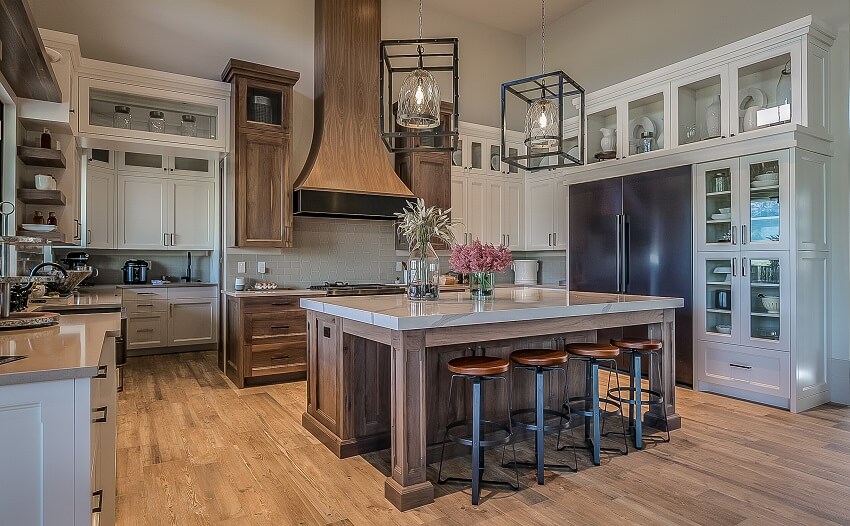
The section behind your stove is the most disastrous area to clean oil marks, food spills, and any other type of residue that is tough to clean.
That’s why choosing the most water-resistant, fireproof, and easy-to-clean backsplash behind the stove would be wise. It makes sense if that means changing your backsplash’s type and design.
For example, if the type you installed on top of your kitchen counters is just thin peel-and-stick wallpaper or low-quality wood material, changing them out is a smarter idea.
Backsplash materials behind your stove, such as ceramic, glass, marble, or anything more heat-resistant, waterproof, easy-to-clean, and durable than peel-and-stick or wood, are a good choice.
Is A Backsplash Behind The Stove Only A Good Idea?
If you are on a limited budget but still want an attractive backsplash for your kitchen, you can always place it directly behind the stove. It will still be a good idea; you just need to ensure it can effectively protect your wall, as the stove area can be prone to grease and food splatters.
Visit our ultimate guide to the different types of kitchen backsplash for more related content.

